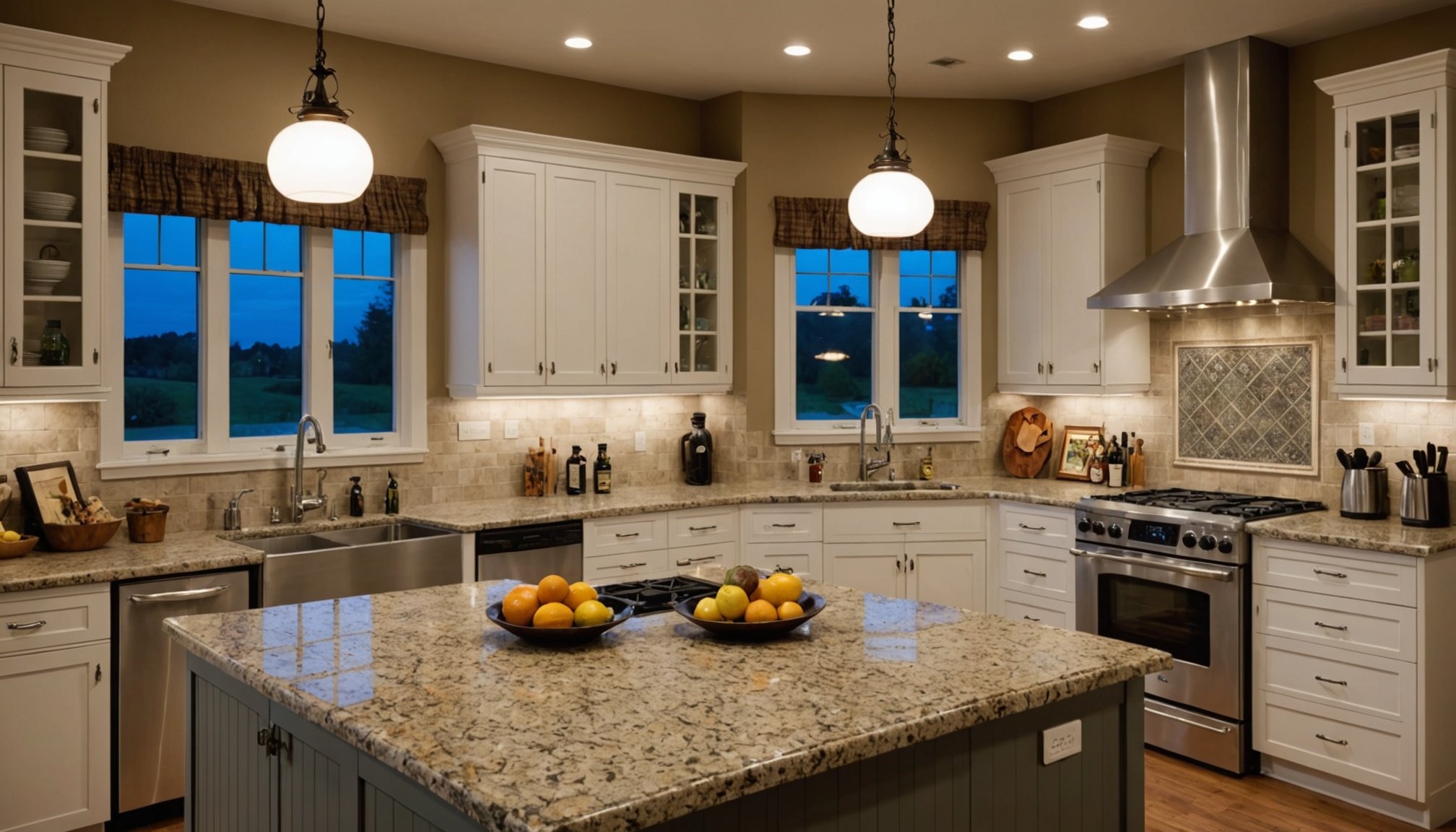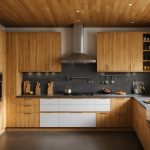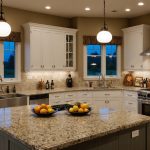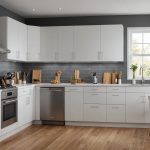Understanding Kitchen Lighting
In the realm of kitchen design, lighting solutions play a pivotal role. The right lighting not only enhances optical brightness but also ensures tasks like chopping and cooking are performed safely.
Glare can be a significant concern in kitchen environments. Excessive glare not only hampers functionality; it disturbs the overall aesthetics of the space. To combat this, incorporating glare reduction techniques is fundamental. This might involve using diffused lighting fixtures or considering the placement and angle of light sources.
Topic to read : Transform your kitchen with bamboo: embrace sustainable style and unmatched benefits
When selecting the ideal lighting scheme for your kitchen, several factors deserve attention. Brightness is crucial, but so is the quality and distribution of light. Consider the different tasks performed in the kitchen—preparation, cooking, and socialising, each requiring varying lighting intensities. Choosing the right balance of ambient, task, and accent lighting can transform your kitchen into a multifunctional hub.
Additionally, the colour temperature of the lighting solutions can impact the mood and appearance of your kitchen. Aim for a consistent warm light for a cosy feel, or opt for cooler tones to accentuate modern finishes. Remember, the key to a successful lighting strategy is in its ability to combine practicality with visual harmony.
Also to discover : Transform your kitchen with bamboo: embrace sustainable style and unmatched benefits
Types of Lighting Fixtures for the Kitchen
Choosing the right types of kitchen lighting can dramatically change your kitchen’s atmosphere. Lighting fixtures not only add functionality but also enhance the kitchen’s aesthetic. Understanding the different fixture types can help create the right balance between form and function.
Ambient Lighting
Ambient lighting serves as the primary source of illumination in the kitchen, setting the overall mood and brightness. This type can be achieved through fixtures like ceiling-mounted lights or recessed lighting. It should be soft yet sufficient to provide a welcoming environment.
Task Lighting
Task lighting focuses on illuminating specific kitchen areas where activities such as chopping or mixing occur. It typically involves under-cabinet lights or pendant lights placed over countertops. Such lighting ensures reduced shadows and focused brightness for safe and efficient cooking.
Accent Lighting
Accent lighting aims to highlight particular features or displays in the kitchen, such as artwork or architectural elements. These fixtures include strip lights or small lamps, adding depth and sophistication. Accent lights are not essential but offer a polished finish to your kitchen’s design.
Each type of kitchen lighting fixture plays a distinct role, working together to create a layered and dynamic kitchen ambiance.
Strategies to Reduce Glare in Kitchen Lighting
Glare in kitchen lighting can strain the eyes and detract from your space’s comfort. One effective approach to glare reduction is thoughtfully considering the placement and direction of your fixtures. Positioning lights to aim away from eye level reduces direct exposure to bright sources, helping mitigate discomfort.
Integrating light diffusers can transform harsh light into a gentle glow. These diffusers scatter light evenly, reducing intensity and shadow. Choosing frosted glass shades or fabric coverings are practical options to soften lighting further.
Additionally, selecting the right bulbs plays a crucial role. Opt for bulbs with lower lumen outputs or warm color temperatures. This subtle choice can significantly decrease the harshness of emitted light. Fixtures designed with adjustable settings allow for tailored brightness, offering flexibility to match your needs and preferences.
Consider soft lighting techniques, such as using multiple light sources within the kitchen. Combining under-cabinet lighting with pendant fixtures creates layered illumination, providing adequate light without overexposure. This strategy not only reduces glare but also enhances the overall ambiance and functionality of your kitchen, encouraging a welcoming and visually appealing environment.
Product Recommendations for Optimal Lighting
Choosing the best kitchen lighting products can significantly influence your cooking space. Now, what are the top LED options? LEDs are ideal for their energy efficiency and brightness. Many homeowners prefer color temperatures ranging from warm (around 2700K) to bright white (up to 5000K) for versatility. An LED like the Philips Hue offers adjustable color temperatures, enabling you to tailor the light setting based on your mood or time of day.
Considering lighting brands, which are renowned in the market? Reputable names like GE Lighting and Philips stand out for high-quality outdoor and kitchen lighting options. GE’s C-Life series is an excellent choice for modern kitchens, known for its ease of connectivity with smart home systems and energy savings.
Looking for user-friendly solutions for DIY installation? Explore products that provide easy installations, such as plug-and-play lights. Brands like IKEA offer straightforward kits that empower users to install lighting without needing professional help. These usually include stick-on LED strips or battery-operated options, providing flexibility without complex wiring. Always ensure the fixtures match your kitchen’s design for seamless integration, enhancing both functionality and aesthetics.
Design Principles for Inviting Kitchen Ambiance
Creating an inviting kitchen ambiance relies on key kitchen design tips, particularly when it comes to lighting. A well-planned lighting scheme enhances both the function and mood of a kitchen space. Start by considering a cohesive lighting scheme. Using similar fixtures and bulb types helps create a seamless flow, tying different areas of the kitchen together visually.
Balance is crucial—you’ll want to marry functionality with aesthetic appeal. Task lighting under cabinets can provide essential illumination for cooking, while pendant lights over an island offer ambiance and style. The color temperature of the lighting can affect the mood as well. Warmer tones are usually more inviting and cozy, whereas cooler lights offer a modern, clean feeling. Choosing a complementary color palette for walls and cabinets can further unify the look, emphasizing the lighting choices.
Successful Case Studies
A case study to consider is a rustic-style kitchen. Here, warm ambient lighting along with focal pendant lamps works with earth-tones to create a cozy environment. A modern minimalist design may employ recessed lighting for a clean appearance, accented by contemporary fixtures to add interest. Using these strategies, any kitchen can become a haven of comfort and style.
Visual Examples and Case Studies
Explore the transformative power of kitchen lighting through real-world examples and expert insights. Before-and-after transformations reveal how strategic lighting can drastically reduce glare. One homeowner initially struggled with harsh overhead lights, causing discomfort and uneven illumination. By switching to layered lighting with under-cabinet fixtures and dimmable pendants, they achieved a more balanced and glare-free environment.
Visual examples highlight effective lighting arrangements that serve both aesthetic and functional purposes. Imagine a kitchen illuminated by a central chandelier paired with recessed lights, creating a warm ambiance while adequately lighting meal prep areas. Such designs not only enhance design inspiration but also improve the overall usability of the space.
Expert commentary further enriches these examples, offering professional assessments of successful lighting transformations. Lighting specialists agree that a combination of task, ambient, and accent lighting creates the most versatile kitchens. They emphasize the importance of adjusting light levels to suit different tasks and times of day, ensuring both efficiency and comfort in the heart of the home.
By considering these examples and expert advice, you can draw inspiration and practical tips for your own kitchen lighting projects.
Expert Insights and Additional Resources
Unlock expert kitchen lighting tips by delving into insights from top lighting professionals. These experts emphasize the importance of layering different light sources. Combining ambient, task, and accent lighting not only enhances the room’s functionality but also contributes to a welcoming atmosphere. Utilizing dimmers allows for flexible lighting adjustments, creating the perfect setting for various occasions.
Apart from expert advice, numerous design resources are available to guide you in achieving an ideal kitchen layout. Websites like Houzz and Architectural Digest regularly feature articles focusing on modern lighting trends and practical implementations. These resources are vital in understanding the nuances between different lighting types and their applications.
For those who still have questions, addressing lighting FAQs can clarify many doubts. For instance, a common question: “How many lumens are needed for a kitchen?” While the precise answer depends on kitchen size and layout, experts generally recommend a minimum of 5,000 lumens. Addressing these common misconceptions and challenges ensures a well-lit, stylish, and highly functional kitchen environment. By consulting expert advice and the right resources, planning your kitchen lighting becomes both manageable and engaging.











